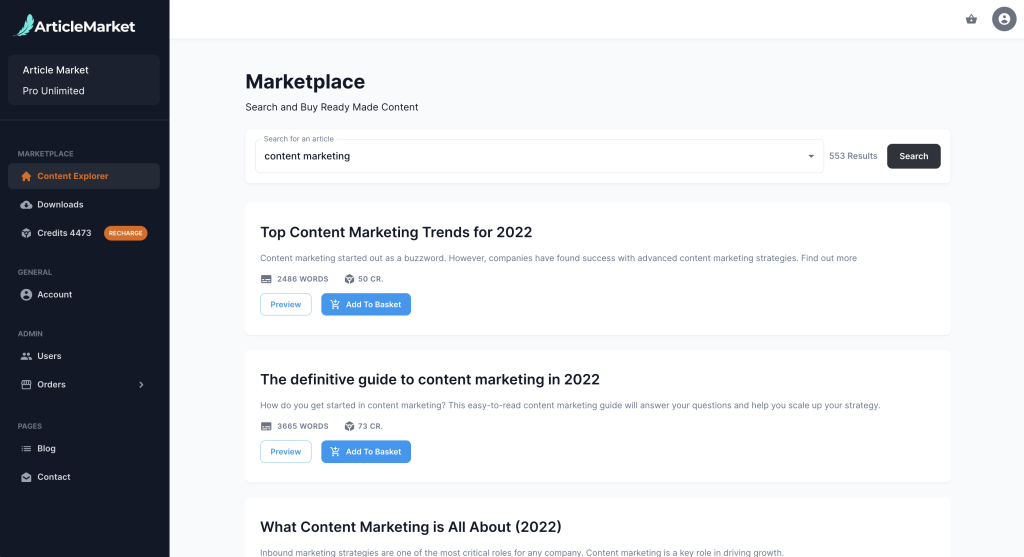The possibilities are endless when it comes to a blank canvas. Whether it’s a blank paper and pen or a blinking cursor, there’s always something to write about.
If you’re feeling uninspired and struggling to come up with ideas for your blog, don’t worry! Today we’re sharing some tips and tricks to help you get your creative juices flowing again.
These methods can be used by any type of blogger, whether you publish on a public blog, send out a weekly newsletter, or run a membership website.
Below are some blog post ideas to get you started and the writing juices flowing.

1. Keep a running list of ideas
An ideas file is a place where writers, bloggers, and publishers can store thoughts, opinions, questions, and prompts for future reference.
No matter how great your memory is, it’s impossible to remember all the great blog post ideas that pop into your head. So keep a running list of ideas somewhere safe, like in a Google Doc or in the notes app on your phone. That way, when inspiration strikes, you can quickly jot down your idea and forget about it until you’re ready to write.
You can even have a notebook dedicated to this, or you can create a folder on your computer.
Social Media Bookmarks
If you come across something interesting on social media, and you want to save it for later, there are plenty of ways you can do so.
- Twitter allows you to favorite tweets, and you can organize your favorites into lists.
- Pinterest allows you to pin, and you can organize pins into boards.
- Instagram allows you to save posts, and you can organize them into collections.
There are also apps you can use to capture and save ideas on your phone or computer.
Here are some of our favorites:
WorkFlowy
WorkFlowy is one of our favorites because the interface is so clean and simple. You can create lists, and within those lists you can create sub-lists. This tool is perfect for brainstorming ideas, and it’s completely free.
Evernote
Evernote is one of the more popular note-taking apps, and for good reason. It’s packed with features, and it’s very versatile. You can sync notes across devices and share notes with others, and you can even create notes from your web browser.
Notion
Notion is an all-in-one tool that allows you to do a lot more than just jot down notes. It’s a great tool for project management and team collaboration, and you can use it to create a wiki or a knowledge base.
Google Keep
Google Keep is a note-taking app from Google, and it’s available on web and mobile. You can use it to create notes, and you can also create to-do lists and reminders. You can even create notes from your Google Calendar.
Appigo Toodledo
Appigo Toodledo is an app that allows you to create to-do lists and tasks. You can also add reminders and subtasks, and you can set priorities. It’s a great tool for productivity, and it’s available on web and mobile.
Simplenote
Simplenote is an app that allows you to create notes, and you can also create to-do lists. Notes are synced across devices, and you can share notes with others. It’s a great tool for productivity, and it’s completely free.
Trello
Trello is a project management tool that allows you to create boards, and within those boards you can create lists. You can also create cards, and you can add comments, due dates, and attachments. It’s a great tool for collaboration, and it’s available on web and mobile.
MindMeister
MindMeister is a mind mapping tool that allows you to create mind maps, and you can also collaborate with others. You can add notes, images, and files, and you can share mind maps with others. It’s a great tool for brainstorming, and it’s available on web and mobile.
2. Get inspired by other bloggers
When you’re feeling stuck, it can be helpful to look to other bloggers for inspiration. See what topics they’re writing about and what angles they’re taking.
This can be done by reading other blogs in your niche, subscribing to newsletters, and following influential people on social media. By doing this, you will get a feel for the types of topics that resonate with your audience and what kinds of posts are most successful.
You can even use a tool like BuzzSumo to see the most popular articles in your niche. Just enter a topic or keyword into the search bar and you’ll get a list of the most popular articles on that topic, along with how many social media shares each one has.
There’s no shame in taking inspiration from those who have found success. There’s a lot to be learned from observing what has worked for others.
Just don’t copy their content verbatim. Take their ideas and make them your own. Make your version better, unique, and valuable.
3. Check out our blog post topics
We know how tough it can be to come up with new and interesting ideas for your blog. That’s why we’ve put together a giant list of blog post topics and ideas to help you out.
4. Ask your audience
If you’re really struggling to come up with ideas, ask your audience!
You can get content ideas from your readers by asking them to reply to your emails or tweets, starting a private community on Discourse or Circle to host conversations, or even meeting up with your audience at in-person events.
Without reader participation and community involvement, many independent bloggers and membership business owners would not be as successful.
Ask your readers what content they would like to see more of and then give it to them. It sounds simple, but surprisingly few people actually do it.
- If you’re a business blogger, ask your readers what they want to learn more about from you.
- If you’re a food blogger, ask them what their favorite comfort foods are.
- If you’re a personal blogger, ask them about the times in their lives when they feel the most themselves.
- If you’re a travel blogger, ask your readers what their favorite travel destinations are.
- If you’re a fashion blogger, ask your readers what their favorite fashion trends are.
- If you’re a beauty blogger, ask your readers what their favorite beauty products are.
The possibilities are endless. Once you know what your readers want to read more of, give it to them. Write blog posts that are informative, helpful, and entertaining. Write blog posts that make your readers smile, laugh, and think.
5. Buy Blog Posts at ArticleMarket.org!
There are many reasons to buy blog posts. Perhaps you don’t have time to write blog posts yourself, or maybe you want to outsource content creation to save time. Regardless of the reason, buying blog posts can be a great way to get high-quality content for your blog.
Are you looking for ways to improve your blog and generate more leads?
Article Market can help!
We can provide high-quality blog posts that will help you attract more readers and grow your business. We can help with everything from coming up with topics and ideas, to writing and publishing the final product.
Contact us today to learn more.
6. Look at Google Analytics
Your analytics can be a goldmine of ideas. See what topics your readers are most interested in and write more on those topics. You can also use your analytics to see what posts are getting the most traffic and write similar posts.
Behavior Reports
Assuming you have a Google Analytics account for your blog, you can generate post ideas by looking at the behavior flow report. This report can be found under “Behavior” in the left sidebar.
The behavior flow report shows you how users interact with your site. You can use this information to generate ideas for new blog posts. For example, if you see that a lot of users drop off after viewing a certain page, you could write a post addressing the issue that they are having.
Audience Reports
In your “Audience” reports, you can see data on who is visiting your website, what pages they’re viewing, how long they’re spending on your site, and more. This data can give you insights into what topics your audience is interested in and what kinds of content they’re responding to.
To find your “Audience” reports in Google Analytics, log in to your account and click “Audience” in the left-hand sidebar. Then, click on the “Overview” tab to see an overview of your audience data.
From here, you can click on the “Behavior” tab to see more detailed information on your audience’s behavior on your site. This data can help you determine what topics to write about in your blog posts.
For example, if you see that a lot of people are spending a long time on your product pages, you might want to write a blog post about how to use your products or what benefits they offer.
Or, if you see that people are leaving your site after viewing only one page, you might want to write a blog post about a specific topic that they’re interested in.
Acquisition Reports
Another way to get ideas for blog posts from Google Analytics is to look at the referrals report. This report can be found under “Acquisition” in the left sidebar.
The referrals report shows you which websites are sending traffic to your site. If you see a website that is sending a lot of traffic, you could write a post about that website or do a guest post on their site.
7. Revisit old blog posts
Assuming you have Google Analytics installed on your website, you can find your most popular blog posts by following these steps:
- Log in to your Google Analytics account.
- Click on “Behavior” in the left sidebar.
- Click on “Site Content.”
- Click on “All Pages.”
- Sort the results by “Pageviews.”
These are your blockbusters.
For weeks, months, and years after publishing they still continue to attract new visitors.
Is the content in this post outdated?
If the answer is yes, then you’ve got a solid strategy for repurposing your content. Not only will you save time and money by repurposing your content, but you’ll also be able to reach a wider audience and get more leads.
If you want to improve your SEO, one easy way is to update your existing posts. This guide from AHREFs explains how to do a content audit and update your best posts.
8. Take a walk
Seriously, this is one of my favorite and go to methods.
Getting out of the house can do wonders for your creativity. If you’re feeling stuck for blog post ideas, take a walk and let your surroundings inspire you.
See something interesting? Take a photo and write a post about it.
Or, simply take in the fresh air and let it clear your mind so that the universe can you send you a sea of ideas.
9. Use prompts
If you’re still having trouble coming up with ideas, try using prompts. There are lots of different prompts you can use, but some of our favorites are:
- What was your most recent lightbulb moment?
- What are you passionate about that no one knows about?
- What’s a topic you’re always arguing with your friends about?
- What’s a skill you’ve always wanted to learn?
- What’s a problem you’re facing in your business?
- What’s a trend you’re seeing in your industry?
- What’s something you wish you could go back and tell your younger self?
- What’s a piece of advice you would give to someone starting out in your industry?
- What’s a myth about your industry that you want to debunk?
- What’s a story from your life that you think would make a great blog post?

10. Recycle existing content
If you’re really struggling to come up with new ideas, look to your old content for inspiration. See if there’s anything you can update or expand upon. You can also repurpose old content into new formats, like turning a blog post into a video.
- Find your most popular blog posts and consider turning them into an ebook or workbook.
- Create a series of blog posts around a specific topic or theme.
- Repurpose old blog posts into new social media content, such as infographics, images, or videos.
- Use old blog posts as the foundation for new, longer-form content, such as an online course or an ebook.
- Transform an old blog post into a brand new one by updating the information, adding new perspectives, or expanding upon the original content.
Learn more about repurposing your existing articles here.
11. Write a detailed guide
One of the best ways to come up with ideas is to think about the questions your readers are asking. And one of the best ways to answer those questions is to write a detailed guide. So if you’re struggling to come up with ideas, try thinking about what kind of guide your readers would find helpful.
Linking your existing posts together (called internal linking) properly is a good way to capitalize on this.
When you’re writing a new post, look for opportunities to link to 2-3 other related posts on your blog.
Not only does this help keep people engaged on your site, it also helps boost your SEO by signaling to Google which of your pages are most important.
Skim through your old posts and group related ones together. See if you can order them in a way that would make sense as a mini-guide, so that reading them sequentially would be more beneficial.
This is a great way to organize your blog if you find that you have a lot of random posts that don’t really fit together.
By grouping them together, you can create a more cohesive guide that will be more valuable to your readers.
12. Borrow another creator or expert’s brain
If you’re still having trouble coming up with ideas, try borrowing someone else’s brain. This could be another blogger, an expert in your field, or even a friend.
If you’re looking for someone to interview in your industry, try contacting a well-known or respected figure. Many people are happy to do interviews, especially if it’s for a publication that their target audience reads.
Some strategies for asking good questions to get subjects talking are to ask open-ended questions, be a good listener, and show genuine interest in the subject matter.
Remember that the quality of your interview is the most important thing.
There are a lot of dull “so tell us who you are and what you do” posts on the internet that don’t contribute anything. Don’t make the same mistakes as them.
In order to make the most of an interview with a subject, the interviewer should do their research and ask questions that the subject may not have been asked in previous interviews. This will allow the interviewer to get new and unique information from the subject.
13. Find out what content your competition is missing
If you want to find ideas that no one else is writing about, do some competitor analysis. See what topics your competitors are writing about and look for content gaps. These are the topics that no one else is writing about but that your audience is interested in.
Your peers and competitors can be a great source of inspiration for your own content marketing strategy.
Take a cue from them by doing some research to find out which keywords they rank for, and take a look at their most popular articles to get an idea of what’s working well for them.
You can also use a tool like Ahrefs to find out what keywords your competitors are ranking for.
We like to use AHREFs to do this research. Their guide on doing an effective content gap analysis is very helpful.
14. Use a tool like Google Trends
If you want to write about topics that are trending, use a tool like Google Trends.
- Go to Google Trends.
- Enter a keyword or phrase into the search bar.
- Scroll down to the “Interest over time” section and take a look at the trends.
- Identify any spikes in interest.
- Use the spikes as inspiration for blog post ideas.
You can also use the “Related Searches” section to find related topics.
15. Check out Quora or Reddit
If you’re looking for blog post ideas, you can try checking out sites like Quora or Reddit.
Quora
Quora is a Q&A platform that allows users to ask and answer questions on a variety of topics. You can use the search function to find questions that are relevant to your blog, and then use the answers to those questions to generate blog post ideas.
There are a few ways to use Reddit for blog post ideas. One way is to use the search function to find relevant subreddits, and then browse through the posts to see if anything inspires you.
Another way is to post in relevant subreddits and see if anyone has any ideas that they would like to share.
16. Check out Google search results
Google is a great place to find ideas. Just enter a keyword into the search bar and scroll through the results. You’ll quickly see what kind of content is popular and what people are looking for.
17. Use Google AdWords Keyword Planner
If you want to find ideas that are popular but not too competitive, use Google AdWords Keyword Planner. Just enter a keyword into the search bar and you’ll see a list of related keywords. You can also use the keyword planner to see how popular a keyword is and how much traffic it could bring you.
18. Look at your bookmarks
If you’re like most people, you have a ton of bookmarks saved that you never look at. But these bookmarks can be a great source of ideas. Just go through your bookmarks and see what topics you’re interested in. You can also use your bookmarks to see what kind of content is popular right now.
19. Check out Pinterest
Pinterest is a great place to find ideas. Just enter a keyword into the search bar and you’ll see a list of popular pins. You can also use Pinterest to see what kind of content is popular right now.
20. Look at your Google search history
Your Google search history can be a great source of ideas. Just go to your Google account and click on “Search History.” You’ll see a list of all the things you’ve searched for. You can also use your search history to see what kind of content is popular right now.
21. Use a tool like BuzzSumo
If you want to find the most popular content on a topic, use a tool like BuzzSumo. Just enter a keyword or topic into the search bar and you’ll see a list of the most popular articles. You can also use BuzzSumo to see what kind of content is popular right now.
22. Look at your social media feeds
Your social media feeds can be a great source of ideas. Just scroll through and see what topics are being talked about. You can also use your social media feeds to see what kind of content is popular right now.
23. Train your idea muscle
The more you practice coming up with ideas, the easier it will be. So make it a habit to brainstorm ideas every day. Set a timer for 10 minutes and see how many ideas you can come up with. The more you do this, the easier it will be to come up with great ideas when you need them.
Conclusion
The potential for success in a creator business often depends on the content and ideas a person has. If you don’t have interesting content and concepts to share, your audience will leave you quickly. Quality and quantity are important to build your community.
Now is the time to get started on your ideas file. See what you can learn from the top creators in your field, and never be afraid to hit the publish button.
What are your go-to resources when you need new content ideas? Share in the comments below!


